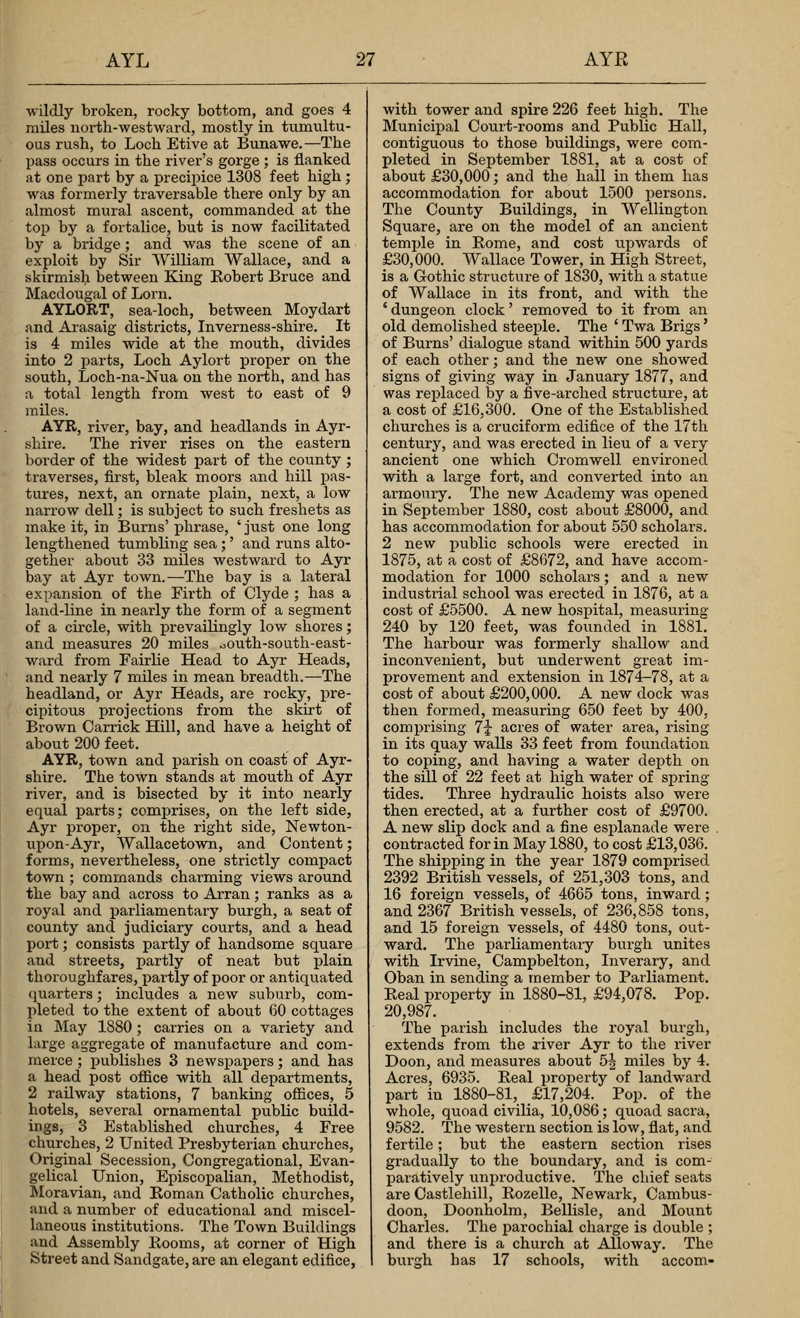AYLORT, sea-loch, between Moydart and Arasaig districts, Inverness-shire. ^ It is 4 miles wide at the mouth, divides into 2 parts, Loch Aylort proper on the south, LochnaNua on the north, and has a total length from west to east of 9 miles.
AYR, river, bay, and headlands in Ayrshire. The river rises on the eastern border of the widest part of the county ; traverses, first, bleak moors and hill pastures, next, an ornate plain, next, a low narrow dell ; is subject to such freshets as make it, in Burns' phrase, ' just one long lengthened tumbling sea ; ' and runs altogether about 33 miles westward to Ayr bay at Ayr town. The bay is a lateral expansion of the Firth of Clyde ; has a land-line in nearly the form of a segment of a circle, with prevailingly low shores ; and measures 20 miles south-south-east-ward from Fairlie Head to Ayr Heads, and nearly 7 miles in mean breadth. The headland, or Ayr Heads, are rocky, precipitous projections from the skirt of Brown Carrick Hill, and have a height of about 200 feet.
AYR, town and parish on coast of Ayrshire. The town stands at mouth of Ayr river, and is bisected by it into nearly equal parts; comprises, on the left side, Ayr proper, on the right side, Newton-upon-Ayr, Wallacetown, and Content; forms, nevertheless, one strictly compact town ; commands charming views around the bay and across to Arran ; ranks as a royal and parliamentary burgh, a seat of county and judiciary courts, and a head port ; consists partly of handsome square and streets, partly of neat but plain thoroughfares, partly of poor or antiquated quarters ; includes a new suburb, completed to the extent of about 60 cottages in May 1880 ; carries on a variety and large aggregate of manufacture and commerce ; publishes 3 newspapers ; and has a head post office with all departments, 2 railway stations, 7 banking offices, 5 hotels, several ornamental public buildings, 3 Established churches, 4 Free churches, 2 United Presbyterian churches, Original Secession, Congregational, Evangelical _ Union, Episcopalian, Methodist, Moravian, and Roman Catholic churches, and a number of educational and miscellaneous institutions. The Town Buildings and Assembly Rooms, at corner of High Street and Sandgate, are an elegant edifice, with tower and spire 226 feet high. The Municipal Court-rooms and Public Hall, contiguous to those buildings, were completed in September 1881, at a cost of about 30,000 ; and the hall in them has accommodation for about 1500 persons. The County Buildings, in Wellington Square, are on the model of an ancient temple in Rome, and cost upwards of 30,000. Wallace Tower, in High Street, is a Gothic structure of 1830, with a statue of Wallace in its front, and with the * dungeon clock ' removed to it from an old demolished steeple. The ' Twa Brigs ' of Burns' dialogue stand within 500 yards of each other; and the new one showed signs of giving way in January 1877, and was replaced by a five-arched structure, at a cost of 16,300. One of the Established churches is a cruciform edifice of the 17th century, and was erected in lieu of a very ancient one which Cromwell environed with a large fort, and converted into an armoury. The new Academy was opened in September 1880, cost about 8000, and has accommodation for about 550 scholars. 2 new public schools were erected in 1875, at a cost of 8672, and have accommodation for 1000 scholars ; and a new industrial school was erected in 1876, at a cost of 5500. A new hospital, measuring 240 by 120 feet, was founded in 1881. The harbour was formerly shallow and inconvenient, but underwent great improvement and extension in 1874-78, at a cost of about 200,000. A new dock was then formed, measuring 650 feet by 400, comprising 1\ acres of water area, rising in its quay walls 33 feet from foundation to coping, and having a water depth on the sill of 22 feet at high water of spring tides. Three hydraulic hoists also were then erected, at a further cost of 9700. A new slip dock and a fine esplanade were . contracted for in May 1880, to cost 13,036. The shipping in the year 1879 comprised 2392 British vessels, of 251,303 tons, and 16 foreign vessels, of 4665 tons, inward ; and 2367 British vessels, of 236,858 tons, and 15 foreign vessels, of 4480 tons, out-ward. The parliamentary burgh unites with Irvine, Campbelton, Inverary, and Oban in sending a member to Parliament. Real property in 1880-81, 94,078. Pop. 20,987. The parish includes the royal burgh, extends from the xiver Ayr to the river Boon, and measures about 5J miles by 4. Acres, 6935. Real property of landward part in 1880-81, 17,204. Pop. of the whole, quoad civilia, 10,086 ; quoad sacra, 9582. The western section is low, flat, and fertile ; but the eastern section rises gradually to the boundary, and is comparatively unproductive. The chief seats are Castlehill, Rozelle, Newark, Cambusdoon, Doonholm, Bellisle, and Mount Charles. The parochial charge is double ; and there is a church at Alloway. The burgh has 17 schools, with accom-raodation for about 4226 scholars, and Alloway has 1 with accommodation for 148.

